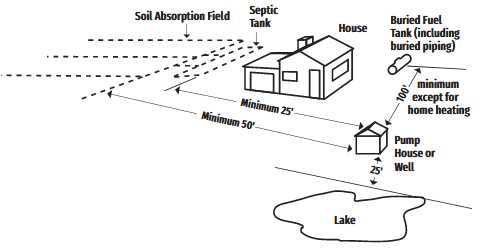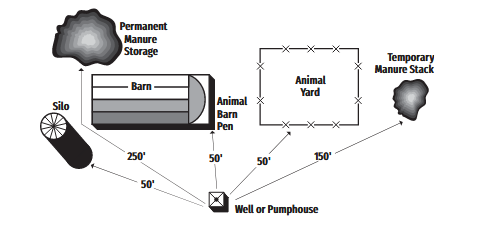Well drilling in Wisconsin has had well regulations since 1936, and today is recognized as a national leader in well protection. NR 812, Wis. Adm. Code, is the state Well and Pump Code administered by the Department of Natural Resources (DNR). The Well and Pump Code is based on the sound premise that if a well and water system is properly located, constructed, installed and maintained, the well should provide safe water continuously without the need for treatment. Do you need a water well in the Waupaca area?
Pro Tip
The typical modern residential well is an amazing resource and can produce many years of excellent water with minimal servicing. Most wells can operate for many years without maintenance. Although your well water delivery may be consistent, your well water quality may not be. You should test your water once a year for contamination to ensure its safety.
Well Drilling – Water Wells
Water wells should always try to be located up-slope and as far as possible from potential sources of contamination. Groundwater is affected by gravity and therefor flows “down hill” just like above ground water. Locating your well near a forested area is best, if such a location is available, and away from fields and other such areas where contamination can occur. Some well location requirements include:
- 8 feet from an approved building sewer pipe.
- 8 feet from a swimming pool, culvert or ditch.
- 25 feet from a septic or holding tank.
- 25 feet from the high-water mark of a lake, pond or stream.
- 25 feet from surface fuel oil, gasoline or other liquid product tank =<1500 gallons.
- 100 feet from any pit, buried petroleum tank or surface tank, >1500 gallons including any piping.
- 50 feet from a non-watertight privy, Private Onsite Wastewater Treatment System or POWTS (dispersed component, soil absorption unit) (drainfield), or mound system.
- 25 feet from a municipal collector sewer.
- 50 from an animal yard, animal shelter, or animal barn.
- 250 feet from a salvage yard or a salt storage area.
- 25 feet from a watertight vault privy.
- 1,200 feet from any existing, proposed or abandoned landfill site.
This is not a complete list. For more complete requirements please consult NR 812.


You Should Know
Human activities and various land uses, such as septic systems, barnyards or fertilized fields, may contribute to groundwater contamination. Gravity pulls water that soaks into the ground under these areas almost straight down to the water table. Contaminants may be dissolved and carried along as well. The soil filters out some of these materials, but may not be able to remove them all.
Water Wells – Testing
While most private water wells in Wisconsin provide safe drinking water, some may become contaminated with bacteria and other contaminants that are not filtered out when the water soaks into the ground. Take action immediately if you suspect there is a problem with your water or if you notice a water quality change.
Collecting a water sample for testing isn’t as easy as turning on the tap. In fact, well owners frequently get false positives because they do not properly collect the sample or fail to get the sample to the testing lab within the 48 hours required for an accurate test. If you need your well water tested please give us a call. We can provide you with a free quote for testing your water. If your test determines there are contaminates in your water we can also provide you with quotes for a new well or filtration system to remove the them.
